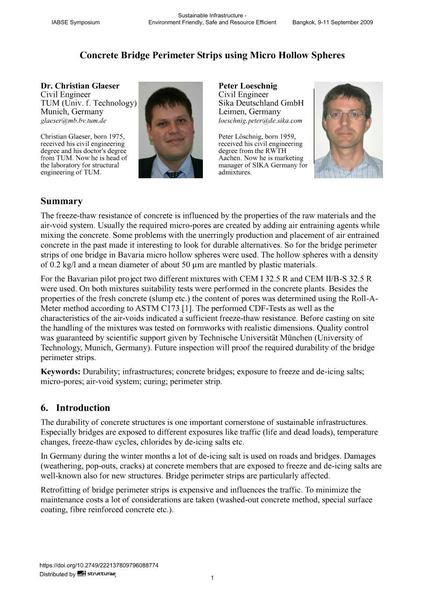Concrete Bridge Perimeter Strips using Micro Hollow Spheres

|
|
|||||||||||
Bibliographic Details
| Author(s): |
Christian Glaeser
Peter Loeschnig |
||||
|---|---|---|---|---|---|
| Medium: | conference paper | ||||
| Language(s): | English | ||||
| Conference: | IABSE Symposium: Sustainable Infrastructure - Environment Friendly, Safe and Resource Efficient, Bangkok, Thailand, 9-11 September 2009 | ||||
| Published in: | IABSE Symposium Bangkok 2009 | ||||
|
|||||
| Page(s): | 75-84 | ||||
| Total no. of pages: | 8 | ||||
| Year: | 2009 | ||||
| DOI: | 10.2749/222137809796088774 | ||||
| Abstract: |
The freeze-thaw resistance of concrete is influenced by the properties of the raw materials and the air-void system. Usually the required micro-pores are created by adding air entraining agents while mixing the concrete. Some problems with the unerringly production and placement of air entrained concrete in the past made it interesting to look for durable alternatives. So for the bridge perimeter strips of one bridge in Bavaria micro hollow spheres were used. The hollow spheres with a density of 0.2 kg/l and a mean diameter of about 50 µm are mantled by plastic materials. For the Bavarian pilot project two different mixtures with CEM I 32.5 R and CEM II/B-S 32.5 R were used. On both mixtures suitability tests were performed in the concrete plants. Besides the properties of the fresh concrete (slump etc.) the content of pores was determined using the Roll-A- Meter method according to ASTM C173 [1]. The performed CDF-Tests as well as the characteristics of the air-voids indicated a sufficient freeze-thaw resistance. Before casting on site the handling of the mixtures was tested on formworks with realistic dimensions. Quality control was guaranteed by scientific support given by Technische Universität München (University of Technology, Munich, Germany). Future inspection will proof the required durability of the bridge perimeter strips. |
||||
| Keywords: |
durability curing concrete bridges infrastructures exposure to freeze and de-icing salts micro-pores air-void system perimeter strip
|
||||
